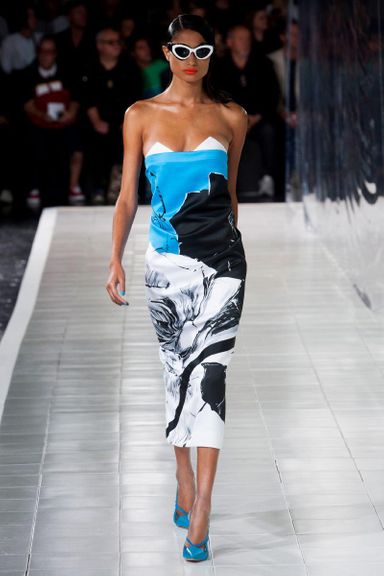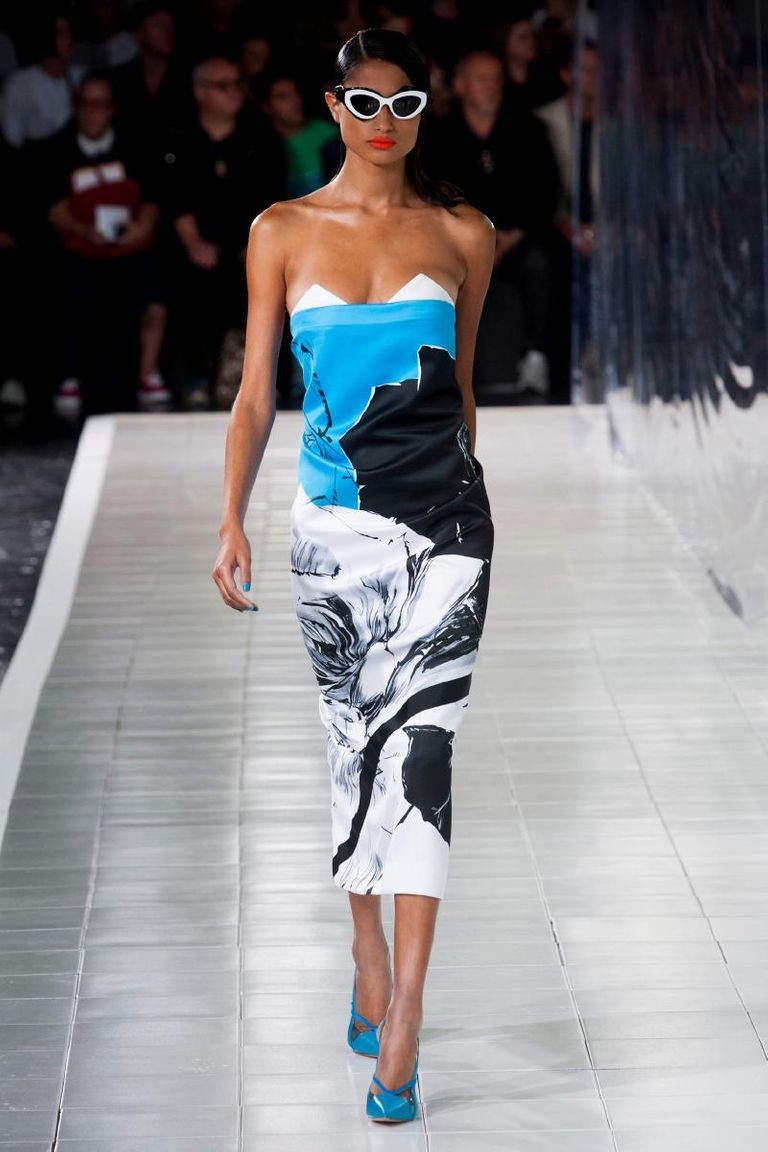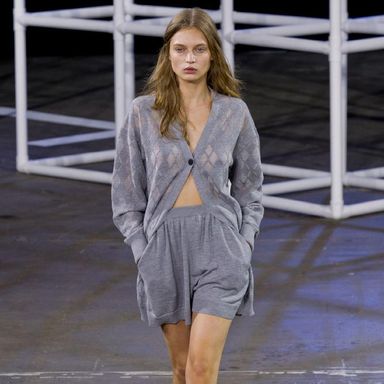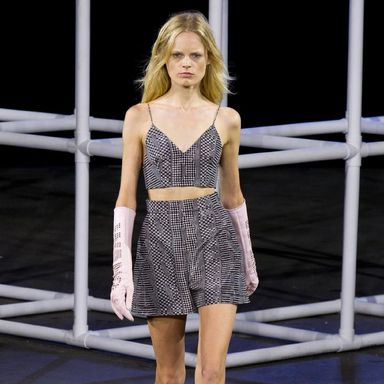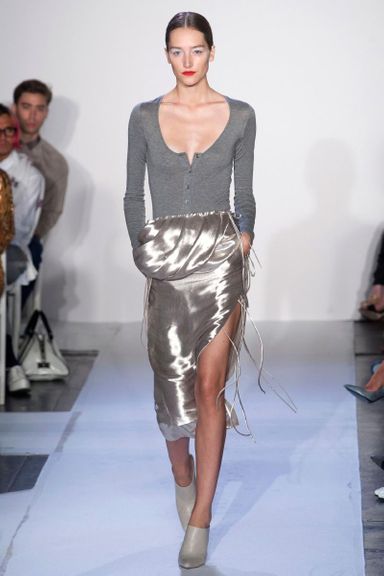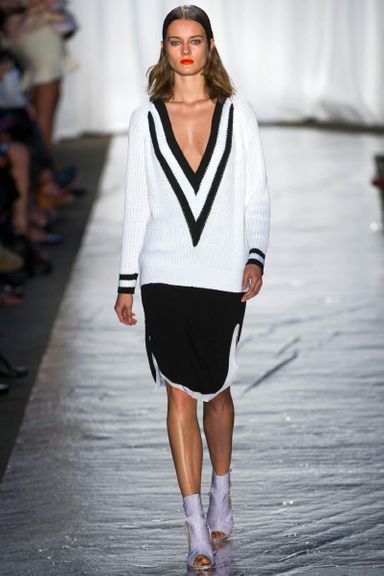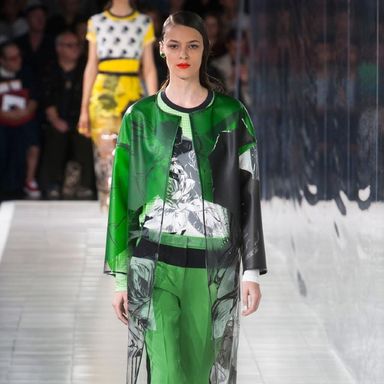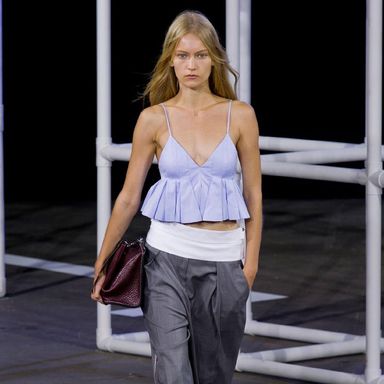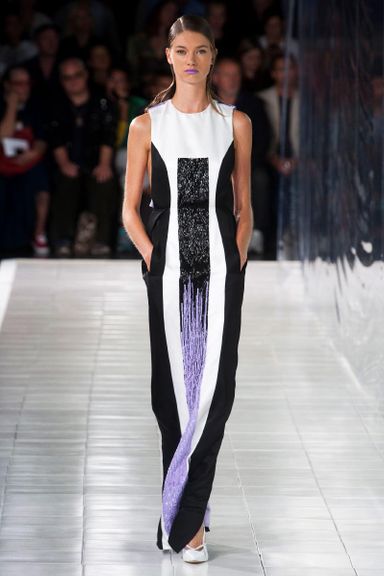The Street and the Future at Alexander Wang, Prabal Gurung, Altuzarra, and rag & bone
There are two things that designers cannot resist trying to do: predict the future, and replicate the energy of the street. Both are perilous endeavors.
The future never seems to go as expected: Styles that were once declared daringly progressive — those Pierre Cardin menswear ensembles with their Nehru-collared jackets and Rudi Gernreich’s audacious topless swimsuit — now seem like loony science fiction. And the intoxicating energy of life on the street, where happenstance bumps up against serendipity, is the kind of fleeting magic that’s nearly impossible to define, let alone consistently mass produce.
Yet the preeminent young designers who showed at Fashion Week on Saturday — Alexander Wang, rag & bone, Prabal Gurung, and Joseph Altuzarra — mostly managed to, if not entirely conquer the challenges of futurism and the street, at least wrestle them to a draw.
Since launching his womenswear line in 2007, capturing street life is precisely what Alexander Wang has been able to do. He made his mark by creating clothes that, as he put it, women want to wear. They were not fanciful or ostentatiously designed. But they captured the insouciance of a young woman who knows she is beautiful, popular, and cool and so is freed from the pressure to primp and to preen. Wang exploited the “model-off-duty” look — slim jeans, blousy T-shirts, tomboy jackets. His could also be described as “walk of shame” style — so perfectly disheveled and rumpled that one could almost smell the stale beer and cigarettes.
Wang coupled this nonchalant aesthetic with an impish, devil-may-care spirit. His after-parties became as hot a ticket as his fashion shows. His skills and reputation proved irresistible to the Paris-based Balenciaga when it went in search of a new designer in 2012.
So here sits Wang: part of the French fashion establishment and at the helm of a New York business with a global reach that has reported revenue in the tens of millions of dollars. He has a lot to lose, and his influence is substantial. In recent seasons, his namesake collection has been more polished and refined – a bit safer, a bit more adult. It still offers a nod to the street, but those streets are just as likely to be in a suburban cul-de-sac as in the heart of a tough city.
Nonetheless, Wang’s posture remains subversive: His settings are dark and spare, his music is aggressive.
For spring 2014, that delicate balance is played for effect. On one hand, he offered dainty pleated gray mini-dresses, a prim gray knit cardigan with subtle burn-out patterns of argyle, and fancy shorts and windbreakers in a techno tweed. On the other hand, he crafted leather pullovers with his name spelled out in row after row of laser cut-outs. Pleated skirts had wide waistbands embroidered with his name, and elbow-length gloves were carved with the word WANG. Through today’s fashion lens, it looked like the kind of merchandise peddled by one of New York’s corner barkers to unsuspecting tourists visiting from Podunk. But it was also reminiscent of the bawdy logo gear favored by rappers back in the day.
Perhaps the branded pieces were meant to be ironic. Perhaps they were intended to remind Wang’s audience that despite his rise in the industry, he remains edgy, cool, and fun. The music certainly made a pitch for a good party, enviable youth, and the pleasures of giving the finger to propriety. As the first model hit the runway, the speakers blared Pharoahe Monch’s “Simon Says,” with its lumbering, pounding bassline and its aggressive call to “Get the F— Up!”
But then just as you might have been ready to jump up and swagger, along would come some nicely tailored gray trousers with a wide white cummerbund waist and a little pleated cropped tank top — all prissy and sanitized. And a voice inside your head yelled, “What are you thinking, Taylor Swift? Sit the heck down!”
The show was like a 15-minute awkward meditation on the definition of cool by a designer who must figure out how to maintain that ineffable magic as he becomes increasingly corporate. Wang is no longer a rising star; he is a star. In some ways, his trajectory is reminiscent of Marc Jacobs’s, who also went from being the coolest wise guy in the room to an executive in the heart of corporate Paris. Jacobs’s terribly, unapologetically late-starting shows seemed to represent an unwillingness to lose his edge.
And then, for fall 2008, his show began a mere seventeen minutes late. (Now, he has been known to start early.) The collection, with shawl-colored coats and draped trousers, was grown-up and inspired by something as simple – and as complicated – as life. Today, Jacobs’s clothes are still progressive, surprising, and youthful. But they are not street cool; they are better than that.
The street can be as powerful as jet fuel for designers. But at some point, managing the resulting success means losing some of that early raucous freedom and transforming one’s aesthetic into something more sustainable. The struggle for Wang lies in minimizing the loss and finding the substance behind the attitude.
Marcus Wainwright and David Neville are not so much hipsters in the style of Wang as they are ex-patriot British rogues. Their best clothes reflect masculine tailoring, biker cool, and girl-power confidence. But the rag & bone collection they put on the runway for spring lacked the sure-footedness that always made their models look as though they knew how to handle themselves even in the most unsavory parts of town.
For spring, Wainwright and Neville gave their audience drop-waist dresses, oversized tennis sweaters, loose-fitting trousers, and shades of turquoise and coral that looked more suitable for a suburban garden party than the urban streets.
Adding to the confusion were unflattering styling tricks. Indeed, one had to wonder if the models had collectively committed some terrible sin that inspired the hair and makeup teams to seek revenge. Their hair was lacquered to the scalp and looked like an oily mop that hadn’t been washed in weeks. And their lips were painted a bright coral that practically glowed under the spotlights, and seemed to precede the rest of their faces down the runway by several feet.
The styling is not what the designers are selling, but it’s part of the story. They are the important details that authenticate the main message. And in this case, the main message was such a mish-mash, it’s no wonder the details went awry.
While his colleagues rely on street wizardry, Prabal Gurung leans towards the future.
He gave his audience a collection with all the markers of futurism — PVC coats, mesh inserts, digital prints, and technical fabrics that we continue to imagine will one day defy rain, make air conditioning obsolete, and recharge your mobile phone to boot.
Gurung set the stage for his presentation with a laboratory-like environment. He paved his runway with square, white tiles. Clear plastic curtains hung from the ceiling, creating a rectangular-shaped box that called to mind some sort of chemical disinfection chamber. His models filed in all at once, lining up in two rows as tubes of fluorescent light flickered on and off overhead.
Against the stark white background, they were highly evolved butterflies — colorful, patterned, transformed.
Gurung has always made terrific use of color, and for spring, and he took some of the weakest, wimpiest shades in the spectrum — sea-foam green, turquoise, lilac, baby pink — and toughened them up by mixing them into graphic patterns grounded in black. His hemlines fell to mid-calf, his skirts and dresses were cut close to the body, and his coats were sweeping.
His prints were mostly abstract but rooted in the deconstruction of roses. And where he did not use prints, his fabric was artfully disintegrated to create the silhouette of a flower.
Other designers, such as Nicolas Ghesquière during his time at Balenciaga, have mixed technology with traditional prints to great effect, but Gurung also used flourishes that were reminiscent of the kind of grand salon dresses worn by women in the fifties. Romantic, oversized bows adorned evening gowns. Skirts were stitched up with exaggerated inverted seams that trickled down the derrière like a waterfall of ruffles. One gown, in black and white duchesse silk and satin, was hand-embroidered with tiny jet and lavender beads. It wasn’t aiming to challenge the eye so much as soothe it.
The collection, particularly the eveningwear portion, was a bit like looking at high-tech versions of gowns by Charles James — an American designer who will be the subject of an exhibition at the Metropolitan Museum of Art’s Costume Institute next spring.
Unfortunately, some of Gurung’s daytime pieces were not as artfully executed. They looked clunky and cumbersome. Gurung often struggles with silhouettes that overwhelm and prints that swallow even the most statuesque models. And there were times when elaborate neck-pieces — a collage of metal and Lucite — looked more medicinal than decorative. Still, the collection succeeded in offering a futuristic dream in which the best of the past was not completely lost, and the needs of the present are not wholly ignored.
If street-inspired designers rely on emotion and futurists rely on intellectual curiosity, Joseph Altuzarra combined both in a collection that was intellectually energizing as well as a pure visceral pleasure.
Altuzarra, who recently received a minority investment from the French luxury group Kering, found his inspiration in Japanese Boro clothing, which he described as patched and pieced together everyday garments worn by farmers and fishermen. He wanted to capture the beauty of imperfection and the majesty of the utilitarian.
But there was little that could be described as imperfect in the collection. Mid-calf skirts with bold slits contrasted with short black or white jackets with contrasting textures and exaggerated hand-stitching. French ticking fabric, with its pencil thin stripes in navy and red, was reproduced in silk and used to cut long, lean skirts and breezy tunics with cotton hems.
Glamorous metallic skirts in shades of platinum and gold gently puddled along the hips and then slithered down the legs. Elegantly cut tuxedo jackets draped over bare torsos – the lapels held modestly in place with a tiny, inner strap embellished with crystals and pearls.
Altuzarra has not built his collection on his personality. It is not defined by who he is or what he does after hours. Instead, Altuzarra has defined his company by an artistic vision that explores global culture, femininity, and the interplay of fabrics. His success is dependent not on remaining young or rebellious or hip, but on retaining a sense of curiosity that fuels his creativity.
All these young men are in different stages of building brands that will speak to the way American fashion is defined for the next generation. Wang, Wainwright, and Neville have underscored the importance of the female street icon in sketching out her own style — for them, Seventh Avenue’s role is to simply smooth out the rough patches, create uniform sizing, and sell the clothes back to women with an official stamp of approval.
Gurung wants to make the past modern and move it on into the future. He is, of course, making the risky assumption that the past is worth preserving.
Altuzarra’s goals are less lofty than predicting the future, and less pragmatic than simply giving women clothes they want to wear. He is fully engaged in the present and he is attempting to give women choices that make them feel better: more elegant, more seductive, more beautiful, more inspired.
He’s offering them something better than mere clothes. He’s giving them fashion.
